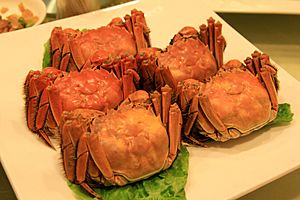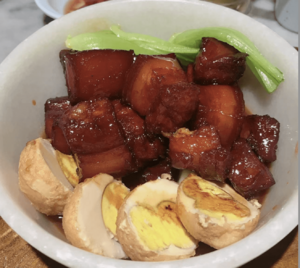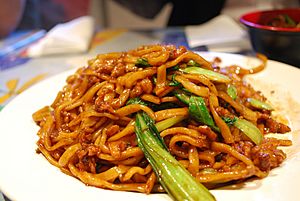Shanghai cuisine facts for kids
Quick facts for kids Shanghai cuisine |
|||||||||||
|---|---|---|---|---|---|---|---|---|---|---|---|
| Chinese | 上海菜 | ||||||||||
|
|||||||||||
| Hu cuisine | |||||||||||
| Simplified Chinese | 沪菜 | ||||||||||
| Traditional Chinese | 滬菜 | ||||||||||
|
|||||||||||
Shanghai cuisine is a popular style of Chinese food. It is also known as Hu cuisine. When people talk about Shanghai cuisine, they often mean Benbang cuisine. This is the traditional local food from Shanghai.
Shanghai cuisine has been shaped by food from nearby Jiangsu and Zhejiang provinces. Like other Chinese foods, it focuses on "color, aroma, and taste." It really cares about using the right seasonings and fresh ingredients. The goal is to keep the original flavors of the food. Shanghai was once part of Jiangsu province. So, its food is very similar to Jiangsu cuisine. Shanghai is a big international city. This means its food has also been influenced by Zhejiang cuisine and even Western cooking styles. This mix of Western and Chinese cooking created a special style called Haipai cuisine.
Contents
What Makes Shanghai Food Special?
Shanghai dishes often look red and shiny. This is because they use a lot of soy sauce for flavor. People often say Shanghai food uses "heavy oil and red sauce." This means it has plenty of oil and soy sauce.
Chefs cook Shanghai food in many ways. They bake, stew, braise, steam, and deep-fry dishes. Some dishes use fish, crab, or chicken. These are made "drunken" using special spirits and quick cooking. They can be steamed or even served raw. Salted meats and preserved vegetables are often added for extra taste. Sugar is also a key ingredient, especially when mixed with soy sauce. Shanghai cuisine uses many kinds of seafood. People in Shanghai usually eat more rice than noodles or other wheat foods.
Shanghai cooking focuses on using spices. But it still wants to keep the natural taste of the ingredients. The flavors are usually light, mild, and a bit sweet. Sweet and sour is a very common taste in Shanghai dishes. How the food looks is also important. Ingredients are cut carefully and arranged to look colorful and nice.
Long ago, in the early 1900s, most families in Shanghai did not eat fish every day. Eating meat was a special treat. Most meals were vegetables, beans, and rice. Families might eat meat or fish only about four times a month. These special days were called dang hun. Today, people pay more attention to healthy food. They try to use less sugar and fat. They also include lots of vegetables for good nutrition.
A Look at Shanghai Food's Past
Shanghai cuisine is the newest of China's ten main cuisines. But it still has a history of over 400 years! It started during the Ming dynasty and Qing dynasty (around 1368-1840). This early food was called Benbang cuisine.
In the late 1800s, Shanghai became a big port for trade. This changed Benbang dishes a lot. After the Shanghai port opened in 1843, many different cooking styles came to the city. Food from Anhui cuisine became popular first. Then, foods from Suxi, Cantonese cuisine, Huaiyang cuisine, and Beijing cuisine also grew popular. By the 1930s, Suxi restaurants made up almost half of Shanghai's eateries. Cantonese food became very trendy. It was loved by both locals and visitors. As Shanghai food took ideas from other cuisines, its flavors became richer and more complex.
Western cooking also influenced Shanghai food. This led to the unique Haipai cuisine style. At first, Chinese people found Western food, like rare steak, hard to get used to. But Shanghai Western food soon mixed ideas from different countries. It created its own special taste. For example, Russian Shanghai Western food became very popular. It often included a dish and a soup, like borscht with bread and butter. Before 1937, Shanghai had over 200 Western restaurants.
Today, you can often find traditional Shanghai dishes in home-cooked meals. Some old Benbang restaurants also serve them. But many young people in Shanghai now enjoy the many international restaurants. Japanese and French food are especially popular.
Popular Shanghai Dishes
Breakfast Favorites
Shanghai breakfast is very famous and has many choices. Most dishes are made from wheat, rice, or flour. Many breakfast foods were influenced by Cantonese, Jiangsu, and Zhejiang cooking. Over time, these dishes became the favorite tastes of Shanghai people today.
The most classic Shanghai breakfast is called "The Four Warriors." These are the four most popular breakfast choices for local Shanghainese:
- Glutinous rice rolls (Cīfàn)
- Soy milk (Dòujiāng)
- Chinese cruller (Yóutiáo)
- Sesame pancake (Dàbǐng)
Delicious Seafood Dishes

- Eel noodles (Mányú Miàn) – These noodles are made with sliced eels and wheat noodles.
- Scallion stewed crucian carp (Cōngshāo Jìyú) – This dish takes a long time to make. The fish is soaked in vinegar, deep-fried, and then stewed for many hours. This makes the fish so tender that you can eat it with all its bones. Because it's so hard to make perfectly, families sometimes used it to test new cooks!
- Shanghai hairy crab (Shànghǎi Máo Xiè) – This is a special type of Chinese mitten crab. It is usually steamed with ginger. People eat it with a dipping sauce made of rice vinegar, sugar, and ginger. Another way to enjoy hairy crab is to mix its meat with lard to make Xiefen. This can be eaten in xiaolongbao or with tofu.
- Squirrel-shaped mandarin fish (Sōngshǔ Guīyú) – This dish uses fresh mandarin fish. The fish is deep-fried, so it's crispy outside and soft inside. It's shaped like a squirrel on the plate and looks yellow and red. Hot broth is poured over it, making a high-pitched sound. This dish combines sour and sweet flavors.
Meats and Poultry
- Beggar's chicken (Jiàohuā Jī) – This dish involves wrapping a chicken in lotus leaves, covering it in mud, and then roasting it in a fire. The result is very tasty and tender chicken. A legend says a beggar in the Qing dynasty stole a chicken and hid it in mud.
- Lion's head (Shīzi Tóu) – The name comes from the large pork meatballs. They are shaped like a lion's head. The cabbage or other vegetables around them look like the lion's mane. There are two types: white (plain) and red (cooked with soy sauce).
- Red braised pork belly (Hóngshāo Ròu) – This dish uses pork belly braised (cooked slowly in liquid) in Shanghainese soy sauce for a long time. This makes the meat very juicy and tender.
- Sweet and sour spare ribs (Táng Cù Páigǔ) – Fresh pork ribs are usually deep-fried. Then they are coated in a sweet and sour sauce. They look shiny and red when ready.
Noodles
- Shanghai fried noodles (Shànghǎi Chǎomiàn) – These are thick fried noodles, sometimes like udon. They are cooked with soy sauce. They are often made with bok choy and pork.
- Chilled noodles (Lěngmiàn) – This dish mixes chilled noodles with different sauces and toppings. The noodles are steamed first for better taste. After they cool, they are mixed with sesame oil, soy sauce, and peanut sauce. People often add leftover food from their fridge as toppings.
- Noodle soup (Tāngmiàn) – Many Shanghai people eat Su-style noodles every day. These usually have two different soup bases to choose from. People add different toppings, mostly meat.
Soups
- Borscht (Luósòng Tāng) – This soup is mainly made of tomatoes and beef. It's an interesting mix of Russian and Shanghai flavors. Its sweet and sour taste is very popular in Shanghai. After coming from Russia, it is now a common dish in Shanghai homes.

Snacks
- Shengjian mantou (Shēngjiān Mántóu) or Shengjianbao (Shēngjiān bāo) – This is a round bun, thicker than a xiaolongbao because it has yeast. It's filled with pork. Then it's pan-fried and topped with sesame seeds and chopped scallions.
- Xiaolongbao (Xiǎolóngbāo) – This is a type of steamed bun. It has a thin dough skin and is filled with pork or minced crab meat, and soup! The tasty soup inside stays until you bite into it.
- Guotie (Guōtiē) – Also known as potstickers. They are like Jiaozi (dumplings). But instead of being boiled or steamed, they are fried in a pan with oil on one side. Then water is added, and the pan is covered to steam the rest of the dumpling. Traditionally, Guotie are filled with ground pork and finely chopped Chinese scallions or cabbage.
- Savory mooncakes (Xiānròu Yuèbǐng) – This is a very typical Shanghai snack. Most mooncakes in China are sweet, with fillings like sesame seeds or red bean paste. But in Shanghai, during the Mid-Autumn Festival, people eat mooncakes with fresh meat. It's a mooncake with meat wrapped in a pastry. You can usually find these fresh mooncakes at local restaurants.
Desserts
- Tangyuan (Tāngyuán) – This is a sweet dumpling made from glutinous rice flour. It's usually filled with black sesame. The town of Qibao has many Tangyuan sellers.
See also
 In Spanish: Gastronomía de Shanghái para niños
In Spanish: Gastronomía de Shanghái para niños




